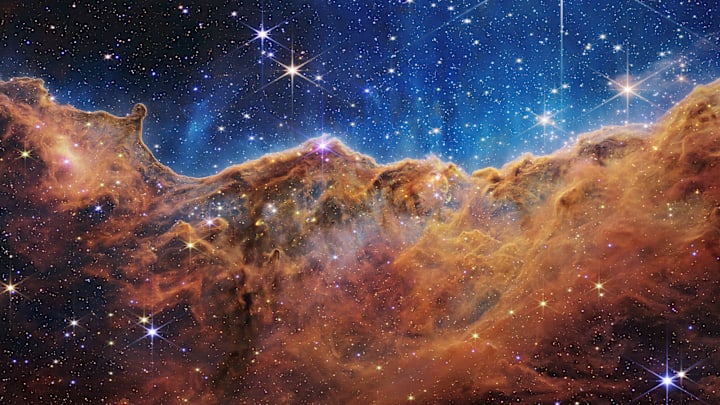NASA has released the deepest, clearest images of the universe ever captured. On July 12, astronomers unveiled five images produced by the new James Webb Space Telescope, an instrument currently in orbit about 1 million miles away from Earth. Its 6.5-meter-wide mirror can grab about seven times more light than the Hubble Space Telescope's 2.4-meter mirror, meaning it can see farther into deep space, and thus back in time—almost to the actual birth of the universe.
The first Webb images show celestial bodies in greater detail than ever before, thanks to the telescope's infrared cameras that can make radiation visible to human eyes. From an image of space as it was more than 13 billion years ago to the death of a binary star, here are just the first of what will be many images poised to transform our knowledge of the universe.

Galaxy cluster SMACS 0723 is pictured in this near-infrared image. Some of the white galaxies in the center of the image appear stretched due to gravitational lensing—gravity exerted by the masses of the galaxies and dark matter behind them. The visible light from the galaxies has been traveling at the speed of light toward Earth for more than 13 billion years.

The James Webb Space Telescope's sensors can detect different wavelengths of light in microns, revealing the chemical composition of celestial bodies. This image shows the makeup of the hot gas giant WASP-96b, an exoplanet about half the size of Jupiter and roughly 1150 light years away from Earth in the constellation Phoenix. Though it orbits very close to its star, its atmosphere contains water vapor—hinting that water exists in multiple places in the universe, not just on Earth.

Webb captured a binary star in the Southern Ring Nebula in the act of dying. On the left, the near-infrared camera depicts the clouds of dust as gas exploding from the center of the star; on the right, its mid-infrared camera reveals the central binary white dwarf as two distinct white dots in the center of the body.

This composite image shows near-infrared and mid-infrared images of Stephen's Quintet. The galaxy on the left is about 40 million light years from Earth, while the other four are roughly 290 million light years away. Each galaxy contains millions of baby stars and trails of gases and dust, while the reddish-gold region between the two galaxies reveals the shockwaves from one crashing into the other. There's even a supermassive black hole in the center of the top-right galaxy.

The big reveal from the first batch of James Webb Space Telescope images is this phenomenal shot of a portion of the Carina Nebula, a stellar nursery about 7600 light years from Earth. The "Cosmic Cliffs" form the edge of a cavity in the nebula carved out by the energy of the massive, hot stars at its center (out of the frame). The "mist" appearing to rise from the edge of the cliff is heated gas and dust pushed out by intense radiation.
